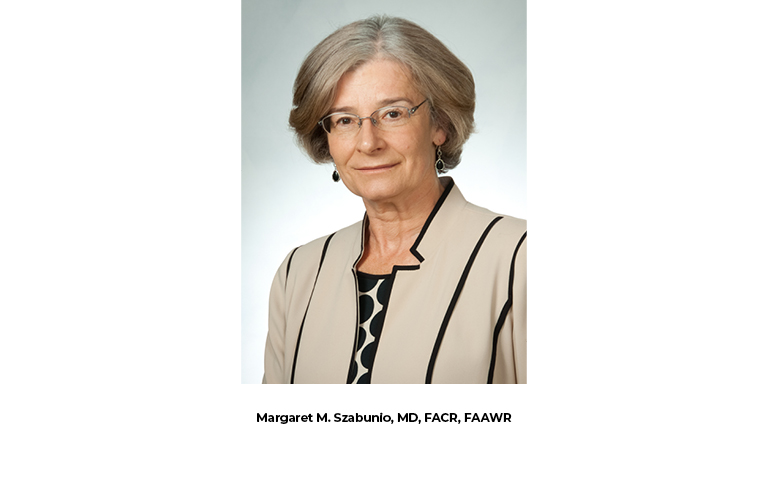The overarching goal of the ACR Accreditation program is to ensure consistency in radiological practice by adhering to established industry standards for every modality — a goal that Margaret M. Szabunio, MD, FACR, FAAWR, chair of the ACR Committee of Accreditation Chairs in the Commission on Quality and Safety and chair of the ACR Committee on Mammography Accreditation, takes very seriously. In a recent interview with the Bulletin, Szabunio — who is professor of radiology, surgery, and biomedical engineering at the University of Kentucky, as well as division chief of women’s radiology and program director of the Women’s Radiology Fellowship at UK HealthCare — shared the ACR Accreditation program’s commitment to improving quality and safety.
Why is the ACR Accreditation program considered the gold standard for quality and safety?
With more than three decades of experience, ACR Accreditation is the oldest and most experienced radiological imaging and radiation oncology accreditation body. By displaying the gold seals of ACR Accreditation, facilities can demonstrate to their patients, payers, and referring providers that they are committed to providing the safest and best quality care possible. We are a gold standard because we are raising the bar for radiology and radiation oncology practices to achieve a higher level of consistent imaging quality.
The ACR Accreditation review program includes physicians, physicists, and technology experts in radiology and radiation oncology. What we’re trying to do is to make sure that we, as representatives of the ACR, are all looking at images and scoring examinations in the same way. To do that, we require education for the reviewers to reduce subjectivity and to make the assessments as objective as possible. So, we all can be proud of giving out an ACR Certificate of Accreditation — meaning that we all believe in and follow the same standards.
Tell us about the ACR Accreditation program’s commitment to improving quality and safety.
The ACR offers accreditation programs in CT, MRI, breast MRI, nuclear medicine, and PET as mandated under the Medicare Improvements for Patients and Providers Act (MIPPA), as well as for modalities mandated under the Mammography Quality Standards Act (MQSA). We aim to ensure we have reproducibility of what we do and continually strive to reduce medical errors, one of the leading causes of death in the U.S. With the ACR Accreditation program, we want to make sure that we, as physicians, are meeting certain standards and also that the images we produce in our institutions are complying with established standards. The ultimate beneficiaries of ACR Accreditation’s rigorous standards are our patients.
What initiatives are currently underway to update and strengthen the ACR Accreditation program?
The ACR Accreditation program is constantly evolving to help facilities keep up with the latest quality and safety guidelines and to deliver the best care possible. Prior to the pandemic, the ACR would perform on-site surveys to validate compliance with regulations and safety standards. Those visits have been one of our best tools to communicate with facilities and personnel and allow them to ask questions.
We have enabled the Radiation Oncology Accreditation and Diagnostic Imaging Center of Excellence™ programs to perform virtual site visits to ensure continuous operation of these important programs. In addition, the FDA has allowed virtual site visits under limited circumstances for mammography facilities. The ACR will soon release an updated accreditation database with many enhancements.
We are also participating in the ACR Learning Network, which seeks to improve diagnostic excellence in imaging with a focus on cancer diagnosis. Four initial improvement collaboratives are supported by a standard process for improvement. What we learn from those collaborations will inform the ACR Accreditation program going forward.
What are some steps that radiologists should take now to improve their quality and safety?
The ACR has many quality improvement programs such as Image Gently® and Image Wisely®. We should all participate in those programs and I encourage all radiologists to “take the pledge” to Image Wisely and get resources and information on radiation safety in adult medical imaging. Image Gently is working to increase awareness of the opportunities to promote radiation protection when imaging children.
I would also encourage all centers to become a designated Center of Excellence, such as the Breast Imaging Center of Excellence, Diagnostic Imaging Center of Excellence, ACR Designated Lung Cancer Screening Center, and ACR Prostate Cancer MRI Center. If all practices strive to become a designated Center of Excellence in these domains, it will help to ensure proper imaging and the best possible interpretation of images, because all the radiologists and RTs will be doing everything they need to do to stay not only at their current level of knowledge, but to raise the bar.
Finally, I am very passionate about the education of residents and fellows, our next generation of radiologists, and we want them to be more successful than we are. It is important for all of us not to lose sight of this perspective: that we are not just looking at images or interpreting images or doing biopsies. There’s a human being behind the images — a person with feelings and fears — and I’ve always tried to teach my residents and fellows how important it is to remember that.

